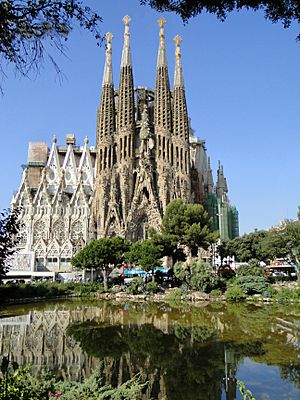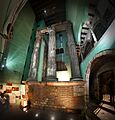Architecture of Barcelona facts for kids

The architecture of Barcelona has grown alongside the rest of Catalonia and Spain. It has followed many different styles from the history of Western architecture. Over its long history, Barcelona has welcomed various cultures. Each one has added its own art style and left behind its mark. This includes early Iberian people, Roman settlers, Visigoths, and a short Islamic period. Later, in the Middle Ages, Catalan art, language, and culture grew strong. This time saw beautiful Romanesque and Gothic buildings.
Contents
History of Barcelona's Buildings
During the Modern Age, Barcelona was part of the Spanish Monarchy. The main building styles were the Renaissance and the Baroque. These styles came from Italy and France. They were used in Barcelona with some local changes. Even though some people say this wasn't a super grand time, the buildings were still very good.
Barcelona's Growth and New Styles
The 1800s brought new life to Barcelona's economy and culture. This led to one of the best times for the city's architecture, called Modernisme. Before the 1800s, Barcelona was squeezed by its old medieval walls. It was seen as a military place, so it couldn't grow much.
Things changed when the walls were torn down. The city also received the Parc de la Ciutadella as a gift. This allowed Barcelona to expand onto the flat land next to it. This big expansion was planned in the Eixample project by Ildefonso Cerdá. It was the largest growth of Barcelona's area ever.
Later, in the late 1800s and early 1900s, Barcelona added several nearby towns. This meant new city spaces needed to be built. The city also ordered many public artworks. Big events like the Universal Exhibition of 1888 and the International of 1929 helped this growth. More recently, the Olympic Games of 1992 and the Universal Forum of the Cultures of 2004 also led to new building projects.
Modern Architecture in Barcelona
The 1900s started with Barcelona's architects trying out new styles. These new styles connected with international trends. In recent years, Barcelona has focused on modern design and new ideas. It also links urban planning with eco-friendly values and sustainability. This has made Barcelona one of Europe's most advanced cities for architecture. It has won many awards, like the Royal Gold Medal in 1999 and a prize at the Venice Biennale in 2002.
Barcelona's important buildings are specially protected by a law from Catalonia. This law makes sure that cultural heritage is kept safe, studied, and shared. Buildings are given different levels of protection.
Where is Barcelona?
Barcelona is the capital city of Catalonia. It is located in eastern Spain, right on the Mediterranean Sea coast. The city sits on a flat area about 5 kilometers wide. It is surrounded by the sea and the Serra de Collserola mountains. The highest point in these mountains is Tibidabo (516.2 meters). The city is also bordered by the deltas of the Besòs and Llobregat rivers.
Above the coastline, separating the city from the Llobregat delta, is the mountain of Montjuïc (184.8 meters). Also, several smaller hills extend from the Collserola mountains towards the flat city area. These hills include La Peira (133 m), El Rovira (261 m), El Carmel (267 m), La Creueta del Coll (249 m), El Putget (181 m), and Monterols (121 m).
Ancient Times in Barcelona
Prehistory: Early Settlements
We have very few clues about the prehistoric period in Barcelona. We know humans were here in the paleolithic (Old Stone Age). But the first building remains are from the Neolithic (New Stone Age). This was when people stopped moving around and started farming.
These early remains are from the late Neolithic (3500 - 1800 BC). They are mostly burial sites called "pit graves." These graves were often deep and lined with stone slabs. One example was found in 1917 near Monterols hill. It was about 60 cm high and 80 cm wide, made of flat, uneven slabs. For homes, only one cabin floor has been found. It was discovered near the current Sant Andreu Comtal train station.
There are also few remains from the Bronze Age (1800–800 BC) in Barcelona. The main ones are from a site found in 1990 on Sant Pau street. Here, they found old fireplaces and single burial sites. Some stone walls and circular cabin floors (about 180 cm across) were found in 1931 near the Hospital of Sant Pau. We also know from old writings that there were two large stone monuments (called megalithic) in Montjuïc and El Camp de l'Arpa. But no physical traces of them remain today. Finally, from the end of the Chalcolithic (Copper Age), there are some small remains of the "urn field culture." These were found in Horta and on the southeast side of Montjuïc mountain.
Iberian Period: Early Tribes
Between 600 BC and 100 BC, the Barcelona area was home to the Laietani. These were an Iberian people living in what are now the regions of Barcelonès, Vallès, Maresme, and Bass Llobregat. Iberian buildings were made with packed earth walls. They used a system of shaped stones, with false arches and curved roofs made by stacking stones closer together.
Cities were usually built on high places, like acropolises. They had towers and strong walls for defense. Inside the walls, houses were usually rectangular and arranged unevenly.
In Barcelona, there are hardly any Iberian building remains. The main traces were found on the hills of La Rovira, Peira, and Putget, and in Santa Cruz de Olorde in Tibidabo. But these haven't shown much about their homes or burial sites. The best remains are from Rovira. In 1931, traces of an Iberian settlement were found there. Sadly, they were destroyed when anti-aircraft batteries were put in during the Spanish Civil War. It seems the settlement had a wall with two entrances. Outside the walls, there were 44 storage pits dug into the rock.
The most important Iberian settlement in the area was likely on Montjuïc. This might have been the ancient 'Barkeno'. However, new buildings on the mountain and its use as a stone quarry over time have caused most remains to be lost. In 1928, nine large storage pits were found in the Magòria area. These were probably part of a warehouse for extra farm products. Also, in 1984, remains of a settlement were found on the southwest side of the mountain. It covered an area of about 2 or 3 hectares.
Roman Period: Barcino's Beginnings
In the 3rd century BC, the Romans arrived in the Iberian Peninsula. They began to colonize the area, eventually making all of Hispania part of the Roman Empire. In the 1st century BC, Barcino (Roman Barcelona) was founded. It was a small walled town built like a military camp, called a castrum, and later a fortified town, an oppidum. The Romans were experts in building and engineering. They created roads, bridges, aqueducts, and cities with clear layouts and basic services like sewers.
The Barcino settlement was surrounded by walls. The wall was 1.5 kilometers long and protected an area of 10.4 hectares. The first city wall was simple and started being built in the 1st century BC. It had few towers, only at the corners and gates. But after attacks by Franks and Alamanni around 250 AD, the walls needed to be stronger. They were made bigger in the 4th century. The new wall was built on the old one's foundations. It had a double wall, 2 meters thick, with stone and mortar filling the space in between. This new wall had 74 towers, most of them rectangular, and about 18 meters tall.
See also
 In Spanish: Arquitectura de Barcelona para niños
In Spanish: Arquitectura de Barcelona para niños
- Urban planning of Barcelona
- The Cerdá Plan
Images for kids
-
Roman archaeological remains, Museum of the History of Barcelona
-
Area inhabited by the Laietani
-
The remaining columns of the Temple of Augustus




